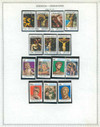
1974-97 Grenada-Grenadines
# MA458 - 1974-97 Grenada-Grenadines
$130.00
Mint collection of about 350 stamps mounted on album pages. Mostly Complete Sets plus many Souvenir Sheets. Some lightly hinged.
Grenada, the smallest independent country in the Western Hemisphere, is 133 square miles located at the very southernmost tip of the West Indies, about 90 miles off the coast of Venezuela, South America. The main island of Grenada is surrounded by about six hundred small islands called the Grenadines, half of which belong to Grenada, and half of which belong to St. Vincent. But even though Grenada is remote, it hasnÕt remained undiscovered. Tourism is becoming an increasingly important industry on this mountainous island.
GrenadaÕs tropical climate, warm sun, and lovely beaches are genuine attractions. That may be how Columbus felt when he first spotted the island of Grenada in 1498. The first settlers on Grenada, however, were French. Next, the British took control of the country. In fact, this British colony didnÕt become an independent republic until 1974. Grenada now has its own constitutional government which is working to increase trade and tourism. Almost everyone in Grenada speaks English.
After a military coup in October 1983 resulted in the execution of Prime Minster Maurice Bishop, U.S. forces invaded Grenada. American troops succeeded in subduing the Grenadian Army and its Cuban advisors.
The people of Grenada offer tourists a wonderfully natural and beautiful spot for those who want to get away from it all. They can stroll along the beaches and live on a simple diet of fish, tropical fruits and drinks. And since there are less than 95,000 residents of the country, theyÕre not apt to feel crowded.
The majority of people (62%) work in the tourist industry, and the rest are occupied in harvesting the main Grenada crops of nutmeg, bananas, cocoa, and sugar. They are primarily people of color, with a mainly Roman Catholic background. Even the capital of Grenada, St. George, has a population of only 30,000 people.
Read More - Click Here
Mint collection of about 350 stamps mounted on album pages. Mostly Complete Sets plus many Souvenir Sheets. Some lightly hinged.
Grenada, the smallest independent country in the Western Hemisphere, is 133 square miles located at the very southernmost tip of the West Indies, about 90 miles off the coast of Venezuela, South America. The main island of Grenada is surrounded by about six hundred small islands called the Grenadines, half of which belong to Grenada, and half of which belong to St. Vincent. But even though Grenada is remote, it hasnÕt remained undiscovered. Tourism is becoming an increasingly important industry on this mountainous island.
GrenadaÕs tropical climate, warm sun, and lovely beaches are genuine attractions. That may be how Columbus felt when he first spotted the island of Grenada in 1498. The first settlers on Grenada, however, were French. Next, the British took control of the country. In fact, this British colony didnÕt become an independent republic until 1974. Grenada now has its own constitutional government which is working to increase trade and tourism. Almost everyone in Grenada speaks English.
After a military coup in October 1983 resulted in the execution of Prime Minster Maurice Bishop, U.S. forces invaded Grenada. American troops succeeded in subduing the Grenadian Army and its Cuban advisors.
The people of Grenada offer tourists a wonderfully natural and beautiful spot for those who want to get away from it all. They can stroll along the beaches and live on a simple diet of fish, tropical fruits and drinks. And since there are less than 95,000 residents of the country, theyÕre not apt to feel crowded.
The majority of people (62%) work in the tourist industry, and the rest are occupied in harvesting the main Grenada crops of nutmeg, bananas, cocoa, and sugar. They are primarily people of color, with a mainly Roman Catholic background. Even the capital of Grenada, St. George, has a population of only 30,000 people.











